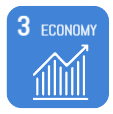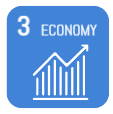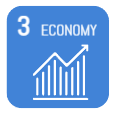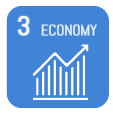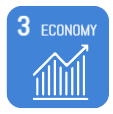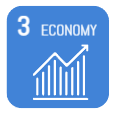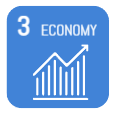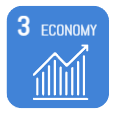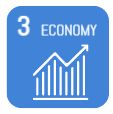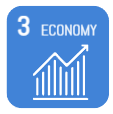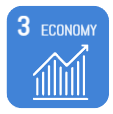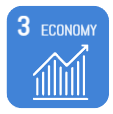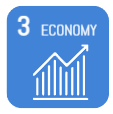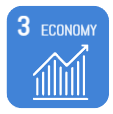4.2.1 - Economic - SEDOs
|
HLG |
Economic SEDOs |
|
|
E1. Labour market activation |
|
|
E2. Entrepreneurship & enterprise start-up |
|
|
E3. Infrastructure & services for micro and small businesses |
|
|
E4. Diversify & support recovery of businesses in sectors facing big challenges |
|
|
E5. Business expansion, targeting high value added sectors & clustering |
|
|
E6. Business infrastructure, investment & connectivity |
|
|
E7. Tourism product expansion & marketing |
|
|
E8. Cultural & creative industries |
|
Policy Framework |
Sustainable Economic Development Objectives |
|
SEDO No. E1 |
Labour Market Activation Support unemployed people to get jobs especially long-term unemployed people, people with disabilities, people with low education and lacking skills, other groups that have very high unemployment rates and people who have been out of work for a long time or are no longer looking for work (economically inactive) |
|
LECP HLGs |
|
|
UN SDGs |
1 No poverty; 2 Zero Hunger; 3 Good health & well-being; 10 Reduce inequalities; 17 Partnership for the Goals |
|
Rationale |
Why is this important? |
|
|
We are at a level of almost full-employment and there isn’t a shortage of jobs in Limerick. However, we have 18 unemployment blackspots, all except one (Rathkeale) in disadvantaged areas of Limerick city. We also have a large percentage of people of working age who are not in work -for instance, due to long-term illness, disability, looking after family or for other reasons. Again, this is especially the case in Limerick City where the employment rate (% of the working age population in work) is 53%, below the city and county average (60%) and the state average (64%) in 2016. Unemployment rates are very high for certain groups. These include people with disabilities, Travellers, people with very low education, people coming off welfare payments, people leaving the prison system, coming out of addiction, migrants and asylum seekers lacking English language skills or not understanding how our labour market works, older workers and those with skills that are no longer needed. There is a presence of all of these groups in Limerick, in urban and in rural areas. As well as representing a loss of economic potential, unemployed and economically inactive people have low incomes and may be living in poverty or are at highest risk of poverty. With the right supports and access to learning, many in these situations may find jobs and get back into work, benefitting themselves, their families and contributing to the economy. Active labour market policies and other complementary programmes – social inclusion, education and learning – aim to get more people into work, targeting long-term unemployed and groups that have highest unemployment and inactivity rates. Under the EU Pillar on Social Rights Action Plan, one of the three high level targets to 2030 is to increase the employment rate of people aged 24 to 64 years to 78%. The target agreed for Ireland is 78.2% by 2030. The mainstream national plan to address and minimise the risk of poverty and social exclusion, the Roadmap for Social Inclusion 2020-2025: Ambition, Goals, Commitments includes as one of its seven goals, to “extend employment opportunities to all who can work”. Local Intreo Offices operating under the Department of Social Protection and the Regional and Local Employment Services are in place in local community settings, targeting supports on long-term unemployed to support them into work. The Social Inclusion and Community Activation (SICAP) programme, delivered by the Local Development Companies, support these groups into employment while at the same time addressing barriers they face and other aspects of exclusion. |
|
Action Areas |
|
|
Questions |
|
|
Policy Framework |
Sustainable Economic Development Objectives |
|
SEDO No. E2 |
Entrepreneurship & enterprise start-up Encourage people of all ages and backgrounds and community and voluntary bodies to get involved in enterprise, contributing to the local economy and job creation |
|
LECP HLGs |
|
|
UN SDGs |
4 Quality Education; 5 Gender Equality; 8 Decent Work and Economic Growth; 9 Industry Innovation and Infrastructure; 12 Responsible Consumption and Production |
|
Rationale |
Why is this important? |
|
|
Business start-ups are important to job creation. They contribute to creating a vibrant local economy bringing new products and services to the market, bringing innovation and adding to local economic activity. It is important to promote enterprise amongst young people, amongst groups such as migrants and women so they consider this as an option for them to participate in the economy. Enterprise can be promoted and enterprise education offered in schools and higher education settings. Innovative enterprises can spin out from R&D in higher education. Community and voluntary organisations can and do get involved in setting up social enterprises. These can be in any product or service sector. They are often enterprises that aren’t viable on a for-profit basis in disadvantaged communities but they provide services or products needed and create employment for local unemployed people. Social enterprise can also bring innovation in responding to social and environmental challenges and can be in areas that involve re-use of waste, upcycling and the circular economy. The Limerick Local Enterprise Office (LEO) is the main local agency supporting entrepreneurship and providing a range of information, advice, training and mentoring programmes as well as access to finance and workspace for enterprise start-up. Other organisations in local communities including the Local Development Companies provide supports especially targeting unemployed, under-employed people and community and social enterprise. Enterprise education and student enterprise projects are also promoted in schools and colleges. |
|
Action Areas |
|
|
Questions |
|
|
Policy Framework |
Sustainable Economic Development Objectives |
|
SEDO No. E3 |
Infrastructure and services for micro & small businesses Put in place workspace, business services and help with access to finance to set up new and support existing small businesses |
|
LECP HLGs |
|
|
UN SDGs |
4 Quality Education; 5 Gender Equality; 8 Decent Work and Economic Growth; 9 Industry Innovation and Infrastructure; 12 Responsible Consumption and Production |
|
Rationale |
Why is this important? |
|
|
Small businesses are important to the local economy, for local employment and a source of innovation. In 2020, 93% of all enterprises located in Limerick were small enterprises and 31% of all jobs in private businesses in Limerick were in companies with 10 persons or less working in them. Infrastructure such as workspace, digital connectivity, venues / places and online platforms to develop sales, business services providing information, advice, mentoring, training programmes in business skills and access to finance are the types of supports needed by start-ups and new businesses so they get established and grow. The Limerick Local Enterprise Office (LEO) provides such supports and services as well as workspace for enterprises. In addition, development and expansion of enterprise in the knowledge economy, in digital and creative sectors are supported by Innovative Limerick, a special company set up by Limerick City and County Council to drive innovation. Innovative Limerick also cooperates with other local authorities in delivering enterprise support services across the Mid-West Region, and the development of a network of digital hub across Limerick, Clare and Tipperary (the “Happen Network”). Having business infrastructure and services in local areas are important to develop and retain local businesses and employment in Limerick. Local businesses trading with each other, initiatives such as buy local campaigns, and business networks can also support expansion and growth and innovation. |
|
Action Areas |
|
|
Questions |
|
|
Policy Framework |
Sustainable Economic Development Objectives |
|
No. E4 |
Diversify and support recovery of businesses in sectors facing big challenges Support businesses in sectors facing the greatest difficulties so they can survive in business and adapt to change. These include sectors worst affected in economic recovery after COVID, and those facing new challenges due to the war in Ukraine, increased energy costs and other issues |
|
LECP HLGs |
|
|
UN SDGs |
4 Quality Education; 5 Gender Equality; 8 Decent Work and Economic Growth; 9 Industry Innovation and Infrastructure; 12 Responsible Consumption and Production |
|
Rationale |
Why is this important? |
|
|
Business sectors that face challenges include retail, due to changes in the way people shop, agriculture and construction, because of increased costs of supplies and change related to climate action, and some manufacturing enterprises that have strong reliance on the UK and are affected by Brexit. Many sectors face difficulties in recruitment of skilled staff and higher costs generally. Retail, construction, hospitality and accommodation and manufacturing make an important contribution to employment in urban and rural Limerick. Service sector employment accounts for more than 50% of all jobs in private enterprise in Limerick, manufacturing some 20% of jobs, enterprise and construction over 10% (2020). Retail, food and hospitality are important to bring vibrancy to our city and town and village centres. The difficulties faced by these businesses are reflected in high commercial vacancy rates in our city and town and village centres. Vacancy rates are approaching or in excess of 20% in Limerick City Centre and at approximately 22% in some county towns (Abbeyfeale and Newcastle West). New models of retail including blended retail are developing where shops combine a traditional “bricks and mortar” function providing display of goods and customer service with online sales (click and collect, delivery). The potential of this for our county towns is outlined in government’s Town Centre First policy document. Recognising the importance of retail to city centre-regeneration and its role in bringing footfall to our city and towns, Limerick City and County Council has developed a Retail Strategy for Limerick Shannon Metropolitan Area and County Limerick (2022-2028). The experience of lockdowns and restrictions on indoor gatherings during COVID led to support for cafés, pubs and restaurants to develop outdoor space for their businesses. This has enhanced the ambience of streets as well as supporting trading / operation of the businesses. In relation to agriculture, this sectors is particularly affected by the agenda for climate action. Adaptation will require change in land use and farm management practices. Agriculture is also impacted by supply chain difficulties (animal feeds) and increased energy costs linked to the war in Ukraine. Changes in agriculture are supported under the new CAP Strategic Action Plan for Ireland (2022) with measures including incentives to transfer land from older to younger farmers, knowledge and capacity building to support new approaches to land management, farming practice, organic farming development and renewable energy on farms. The construction sector is impacted by skills shortages combined with high demand, supply chain issues and high energy costs. Building Future Skills: Government’s policy document, The Demand for Skills in Ireland’s Built Environment Sector to 2030 (2020) identifies the skills required by the Built Environment sector over the next decade to deliver on ambitions related to housing, infrastructural development and climate change mitigation. Although there is high demand in the sector, this is affected by uncertainty in the economic climate including higher interest rates and inflation. |
|
Action Areas |
Target sectors include:
Types of action:
|
|
Questions |
|
|
Policy Framework |
Sustainable Economic Development Objectives |
|
SEDO No. E5 |
Business expansion, targeting high value added sectors & clustering Support established businesses in growth sectors, to expand their businesses in Limerick and grow their workforce |
|
LECP HLGs |
|
|
UN SDGs |
4 Quality Education; 8 Decent Work and Economic Growth; 9 Industry Innovation and Infrastructure; 12 Responsible Consumption and Production |
|
Rationale |
Why is this important? |
|
|
Limerick has been successful in attracting foreign direct investment with some 24,500 jobs announced and €3.4b investment since 2013. There is a number of large multi-nationals located in Limerick and engaged in advanced R&D – such as Johnson & Johnson, Regeneron and Edwards Life Science. There are also successful indigenous enterprises – in manufacturing, food and business services – located in Limerick. Large enterprises, while they comprise less than 1% of all private businesses, account for over 20% of jobs in private enterprise. Limerick has third level education institutions providing a supply of skilled graduates. These institutions also have R&D Research Centres attracting significant investment. They lead research programmes in software design, pharmaceuticals and advanced manufacturing. Building clusters of enterprises including connections between large and small firms, foreign-owned and indigenous companies and R&D / university and industry links can help consolidate existing operations in Limerick, and support expansion and attraction of new investment in similar / related sectors. This is important in creating sustainable jobs with decent incomes for workers. Limerick City and County Council, Innovate Limerick and other partners have been working to build an innovation culture and the infrastructure and services to support that. |
|
Action Areas |
|
|
Questions |
|
|
Policy Framework |
Sustainable Economic Development Objectives |
|
SEDO No. E6 |
Business infrastructure, investment & connectivity Plan and develop business accommodation such as modern office accommodation, factory and other types of space, continue to bring foreign direct investment to Limerick and work to improve the road, rail, air and digital connectivity needed to attract businesses to set up and expand existing operations in Limerick |
|
LECP HLGs |
|
|
UN SDGs |
8 Decent Work and Economic Growth; 9 Industry Innovation and Infrastructure; 12 Responsible Consumption and Production |
|
Rationale |
Why is this important? |
|
|
Attracting foreign companies to locate in Limerick – especially in sectors in advanced manufacturing and services in the knowledge economy - has been very important in expanding and strengthening the local and Mid-West Regional economy and expanding employment that offers decent wages. These companies have also been an important source of innovation. Attracting mobile foreign investment is competitive internationally and within the state as a whole. IDA Ireland’s latest strategy includes a target for 50% of companies being attracted to Ireland to locate in areas outside of the greater Dublin region. It is important that Limerick can compete to attract its share of such investment. Having suitable business accommodation, zoned lands, an educated and skilled workforce, good transport connectivity, high speed broadband, security in energy supply, social and public infrastructures (housing, schools, healthcare) and quality of life are factors that attract such investment to Limerick. The major public investment programmes of government in housing, strategic transport infrastructure, energy and broadband under-pin this objective. The development of strategic sites, especially focused on Limerick city centre, under the Limerick 2030 Economic and Spatial Plan (updated in 2022) including Opera Square (in construction) and Cleeves Riverside Park development (design and planning) in the city centre and expansion and upgrading of enterprise centres in county towns are contributing to this objective. Continuing to show a competitive edge in attracting investment and enterprises to locate in Limerick is an important priority. |
|
Action Areas |
|
|
Questions |
|
|
Policy Framework |
Sustainable Economic Development Objectives |
|
SEDO No. E7 |
Tourism product expansion & marketing Develop more things to see and do in Limerick, indoors and outdoors, and bring more visitors to Limerick all year round |
|
LECP HLGs |
|
|
UN SDGs |
8 Decent Work and Economic Growth; 11 Sustainable Cities and Communities; 12 Responsible Consumption and Production |
|
Rationale |
Why is this important? |
|
|
Limerick is developing in tourism both in city-based and rural tourism. As part of this, Limerick is linking into new trends in cultural, heritage, activity and sports tourism and building and marketing its strengths in these areas. In 2019, Limerick had 602,000 overseas visitors generating revenue of €254 million and 349,000 domestic visitors generating revenue of €51 million. Tourism and international travel were severely impacted by the COVID-19 pandemic. In 2022, visitor numbers to Limerick were still below the levels of 2019. However, passenger numbers through Shannon Airport in October 2022 were at 97% of the seat capacity of October 2019 and hotel occupancy rates are also close to 2019 figures. There is good connectivity to bring overseas visitors directly into Limerick / the region via Shannon Airport. Limerick is also well-located in terms of motorway / main national transport routes. There is a number of visitor attractions in Limerick (e.g., King John’s Castle, the Hunt Museum, the Limerick City Gallery of Art) and there has been public and private investment in tourism infrastructure – such as the Limerick Greenway, Foynes Flying Boat and Maritime Museum, upgrading / expansion of hotels (e.g., Adare Manor) and outdoor facilities (Lough Gur). However, Limerick has not realised its tourism potential. There are opportunities to draw on the natural assets of Limerick to expand in tourism – the river Shannon for leisure-based activities and nature watching, landscapes of east and west Limerick, cultural heritage including history and architectural heritage of the towns and villages along the Estuary, castles and churches in east Limerick towns (Kilmallock, Kilfinane), the railway heritage associated with the Limerick Greenway (developed along the main railway line, the Great Southern, from Limerick to Tralee), the heritage town of Adare, the pre-historic site of Lough Gur and the modern culture (music, literature, arts) of the city and rural towns and villages. Tourism and related industries are an important source of job creation in a labour intensive sector that offers flexible work in a variety of occupations. Limerick City has been designated a Gateway City to the Wild Atlantic Way by Fáilte Ireland which will expand the reach of marketing and promotion of Limerick to visitors. Tourism product development and marketing initiatives are being rolled out to promote Limerick “as a destination”. Rural operators in both east and west Limerick are also collaborating to develop rural tourism destination towns and villages – in the Ballyhoura Mountain and in towns and villages in west Limerick on or traversing the Limerick Greenway. Limerick City and County Council has developed Limerick Tourism Development Strategy and Action Plan 2019-2023 which maps out the key area and targets to expand tourism in Limerick. |
|
Action Areas |
|
|
Questions |
|
|
Policy Framework |
Sustainable Economic Development Objectives |
|
SEDO No. E8 |
Cultural & creative industries Support creatives to earn income from their skills and talents and build up the cultural and creative industries / businesses emerging in Limerick |
|
LECP HLGs |
|
|
UN SDGs |
8 Decent Work and Economic Growth; 11 Sustainable Cities and Communities |
|
Rationale |
Why is this important? |
|
|
This objective under the Economic element of the LECP focuses on the contribution to economic activity and jobs of cultural and creative industries. Other objectives under the Community and Integrated elements support social, community and environmental benefits from culture and the arts and heritage. Limerick City has a profile and assets to develop as a creative and cultural city and has recently had a great deal of success in developing a film industry. Assets include Limerick School of Art and Design, the School of Architecture and product design at UL, the Irish World Music Academy and Creative Writing Centre at UL, Troy Studios and the Film Skills Academy in the city as well as community arts projects and centres in the city and rural Limerick. These operations in themselves generate a body of artistic and creative talent. Limerick has large-scale commercial concert / theatre venues (University Concert Hall, Lime Tree) and new venues for major events (King John’s Castle, the Milk Market, Thomond Park, TUS / Gaelic Grounds). Cultural and creative industries add to the attractiveness of Limerick as a place to live, to visit and as a location for investment and enterprise. Cultural and creative industries are a route to expand the economy and job creation. Creative skills are found within all types of industries and commercial activities including graphic design, communications, publishing, ICT services, engineering / manufacturing design, architecture and other sectors. An economic impact assessment of the contribution of creative industries (in the widest sense) to the Irish economy over 10 years ago (Indecon Economic Consultants, 2011) showed an estimated contribution of €4,703.9 million, 49,306 direct jobs and 78,900 total jobs in 2010. Under Creative Ireland, the Creative Communities Economic Action Fund supports local authorities and other partners including the Local Enterprise Offices and voluntary and community organisations to develop innovative projects that leverage the potential of the creative industries to support local and regional economic development. In addition to its economic impact, culture and creativity can build pride of place and improve quality of life and health and well-being for residents. This is addressed in other parts of the LECP. |
|
Action Areas |
|
|
Questions |
|

